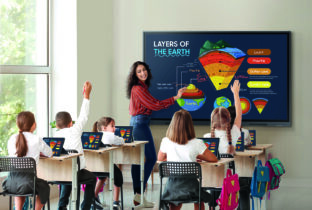Filled with changes and unexpected challenges, 2020 was certainly a year to remember in K-12 education. School closures forced districts around the world to adopt remote learning at an accelerated speed. In the U.S., 52 percent of students started the 2020–2021 school year with a remote-only learning model, while 19 percent did some type of hybrid schooling and only 25 percent attended in-person classes every day.
The widespread, sudden shift toward online public education revealed challenges around technology, teacher support and student access. While enduring the stress of the pandemic and its consequences for education, school districts learned some important lessons that will help them as they move into the future. Here’s a closer look at a few hard-won lessons from 2020.
1. Schools need to reassess education standards and frameworks
A shift from the traditional classroom to online learning requires an overhaul of standards, assessments and teaching methodologies. Districts that want to fare well with remote learning must take those differences to heart and adapt their framework to fit the new delivery model.
“Schools need to reconceptualize their standards and expectations,” says Miguel Gonzales, professor of educational policy and leadership at the University of Nevada, Las Vegas. “Administrators should sit down with teachers and ask them, ‘What does good distance learning instruction look like?'”
2. Districts across the U.S. must address the digital divide
A significant number of K-12 students in the U.S. don’t have access to dependable home internet — and that number turned out to be much larger than previously estimated, according to a study released in June 2020. As many as 15–16 million K-12 students and 400,000 teachers lack adequate internet or computing devices at home.
Fund your remote learning initiative
Learn how to create, present and secure grants for your remote learning technology needs. Download Now
That gap prompted many districts to purchase technology devices for students and teachers this year, but the accessibility problem persists when students can’t get online at home. This digital inequality is prompting districts to consider creative ways to ensure all their students gain the access they need.
3. Teachers and students need to master remote learning before it becomes a necessity
Before 2020, few school districts even considered the possibility of needing to shift to all-remote instruction. That blind spot has vanished in the wake of the pandemic. In the future, districts will build in contingency plans for hybrid and remote learning scenarios in case of public health crises or other disruptions to normal operations. This capability will ultimately strengthen schools, allowing them to be more agile and better able to cope with unexpected shutdowns.
4. Administrators must support teachers with training and resources
Teachers have borne the brunt of the shift to remote learning, and districts are scrambling to provide the training and resources they need to succeed in the new environment. “Teachers are heroes, and I think they are rightfully receiving more respect in the wake of the pandemic,” says Gonzales. “Moving forward, we need to make professional development for teachers and administrators even more of a priority.”
The best way to do that is by asking teachers to communicate their needs — what are the skills they need to sharpen? What types of professional development events or training sessions would benefit them most?
5. Technology purchases should be targeted and timely
When the pandemic hit, many school leaders made large technology purchases for their districts. With urgent needs and little time to deliberate between options like tablets and Chromebooks, many were tempted to act without careful consideration — but taking the time to evaluate the needs of students and teachers and seek their input before making a decision always yields significant benefits in the long haul.
In future, districts will be better prepared to make ed-tech purchasing decisions quickly while heeding opinions from key stakeholders.
Explore the breadth of Samsung’s remote learning solutions. Having trouble choosing? Here’s a rundown of how to choose between Samsung’s Chromebook offerings for students and teachers.









